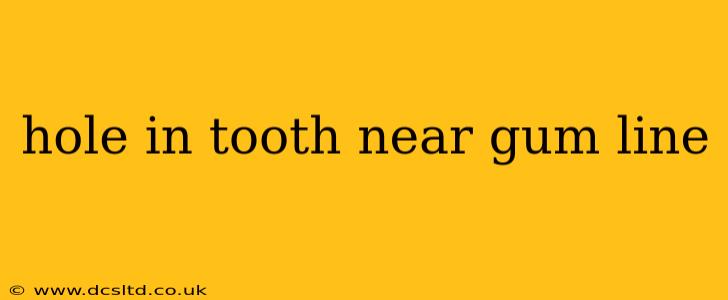A hole in your tooth near the gum line, often referred to as a cavity or caries, is a common dental problem that can cause significant discomfort and potentially lead to more serious issues if left untreated. This area is particularly vulnerable due to its proximity to the gum line, making it difficult to clean effectively. This comprehensive guide will explore the causes, treatments, and preventative measures for this dental concern.
What Causes a Hole in a Tooth Near the Gum Line?
The primary culprit behind tooth decay near the gum line is bacterial plaque. Plaque is a sticky film of bacteria that constantly forms on your teeth. These bacteria feed on sugar and carbohydrates in your diet, producing acids that attack tooth enamel. Over time, this acid erosion weakens the enamel, leading to the formation of a cavity. The gum line area is especially susceptible because:
- Difficult to Clean: The gum line is often difficult to reach with a toothbrush, making it easier for plaque to accumulate and thrive.
- Receding Gums: Receding gums expose more of the tooth root, which is less resistant to decay than enamel.
- Food Trapping: Food particles can become lodged near the gum line, providing additional nourishment for bacteria.
How is a Hole in a Tooth Near the Gum Line Diagnosed?
Your dentist will use several methods to diagnose a hole in your tooth near the gum line:
- Visual Examination: A thorough visual examination using a dental mirror and explorer is the first step.
- X-rays: X-rays are crucial for detecting cavities that may not be visible on the surface. They can reveal decay beneath the enamel or between teeth.
- Dental Probe: A small, blunt instrument (a dental probe) can be gently used to check for soft spots in the enamel, indicating decay.
How is a Hole in a Tooth Near the Gum Line Treated?
Treatment for a cavity near the gum line depends on the severity of the decay:
- Dental Filling: For small cavities, a filling is typically the solution. Your dentist will remove the decayed portion of the tooth and fill the cavity with a composite resin, porcelain, or other suitable material.
- Inlay/Onlay: For larger cavities, an inlay or onlay might be necessary. These are custom-made restorations that fit precisely into the tooth's cavity.
- Crown: If the decay is extensive, a crown (a cap that covers the entire tooth) may be required to restore the tooth's structure and strength.
- Root Canal: If the decay has reached the tooth's pulp (the inner part containing nerves and blood vessels), a root canal may be necessary to remove the infected tissue and prevent further damage. In severe cases, tooth extraction might be the only option.
What are the Signs and Symptoms of a Hole in a Tooth Near the Gum Line?
Early-stage decay may not show any symptoms, which highlights the importance of regular dental check-ups. However, as the decay progresses, you may experience:
- Tooth Sensitivity: Pain or discomfort when consuming hot, cold, sweet, or acidic foods and drinks.
- Discoloration: A brown or black spot on the tooth surface.
- Visible Hole or Pit: A noticeable hole or pit in the tooth.
- Pain or Ache: A persistent ache or throbbing pain in the affected tooth.
- Bad Breath: Persistent bad breath may be a sign of infection.
Can a Hole in a Tooth Near the Gum Line Be Prevented?
Yes, diligent oral hygiene is crucial in preventing cavities near the gum line. Here's how:
- Regular Brushing and Flossing: Brush your teeth twice a day with fluoride toothpaste, and floss daily to remove plaque and food particles from hard-to-reach areas, including the gum line.
- Healthy Diet: Limit sugary and acidic foods and drinks, as these contribute to tooth decay.
- Fluoride Treatments: Fluoride strengthens enamel and makes teeth more resistant to acid attacks. Ask your dentist about fluoride treatments.
- Dental Sealants: Sealants are protective coatings applied to the chewing surfaces of back teeth to prevent decay.
- Regular Dental Check-ups: Schedule regular check-ups and cleanings with your dentist for early detection and prevention of dental problems.
What Happens if a Hole in Tooth Near the Gum Line is Left Untreated?
Ignoring a hole in your tooth near the gum line can lead to several serious complications:
- Severe Toothache: The decay can reach the nerve, causing intense pain.
- Abscess: An infection can develop, leading to a painful pus-filled abscess.
- Gum Disease (Periodontitis): Infection can spread to the gums, leading to gum disease and potential tooth loss.
- Tooth Loss: In severe cases, the tooth may need to be extracted.
This information is for general knowledge and does not constitute medical advice. Always consult with a qualified dentist for diagnosis and treatment of any dental concerns. Regular dental check-ups and proactive oral hygiene are vital for maintaining healthy teeth and gums.
